What is VoIP?
Definition: Voice over Internet Protocol (VoIP) is a highly effective modern calling solution that allows you to place phone calls over a broadband internet connection rather than a traditional landline. Let's explore what VoIP is, how it works, and why any business can benefit from it.

There was once a day and age when placing a call was an expensive, cumbersome experience. From a rotary dial to the brick-sized cell phone, every age of telephony has improved upon the last. Now coupled with cloud technology, Voice over Internet Protocol (VoIP) offers the flexibility, scalability, and always-on performance today's businesses need.
But what about VoIP phone systems helps them stand above the rest? Supported by cloud calling, which integrates meetings, messaging, and contact center into the calling experience, VoIP offers appealing capabilities such as lower costs, higher accessibility, and unprecedented portability that the traditional Public Switched Telephone Network (PSTN) simply can't provide. Given the rise of hybrid work, feature-rich collaborative solutions are becoming increasingly critical for businesses across industries.
In fact, 98% of knowledge workers believe future meetings will include remote participants. With these trends in mind, it's easy to see why businesses are flocking to cloud-based VoIP calling to empower their workforce. The trend is a reality now: for instance, more than 39 million cloud callers use VoIP technology from Webex to make 8 billion monthly calls.
In this guide, we'll explore the ins and outs of VoIP phone calling to help you identify the best service for your business needs.
Who uses VoIP calling technology?

Now that we have a basic understanding of what VoIP is, let's discuss who uses it. Many people leverage VoIP phone services in both their personal and professional lives. When it comes to the former, video conferencing is VoIP's most popular use, but individuals also use VoIP any time they use services like Skype or WhatsApp to place a call.
Given the migration to hybrid work and VoIP calling's range of capabilities, VoIP will only continue to grow in popularity. According to Statista, businesses in the U.S. added more than 35 million VoIP lines between 2010 and 2018, reaching a total of 41.6 million. And during the same time, residential VoIP lines increased from about 20 million to more than 76 million.
Businesses today rely on VoIP to provide secure, reliable, and flexible tools that enable employees to connect and collaborate in real-time. With integrated enterprise-grade calling features, virtual meetings and messaging apps, employees can increase productivity while working from anywhere. Some VoIP features even allow participants to easily transition a call to a meeting and record the entire exchange for future reference. With hybrid work taking on many forms, VoIP makes it easier to connect and continue work regardless of circumstances.
VoIP calling technology can also ease the burden of management by providing a centralized platform from which to monitor performance and administer the entire phone system. For example, VoIP platforms can optimize calls within an organization, streamline bandwidth utilization, and improve call quality and performance.
How does VoIP work?
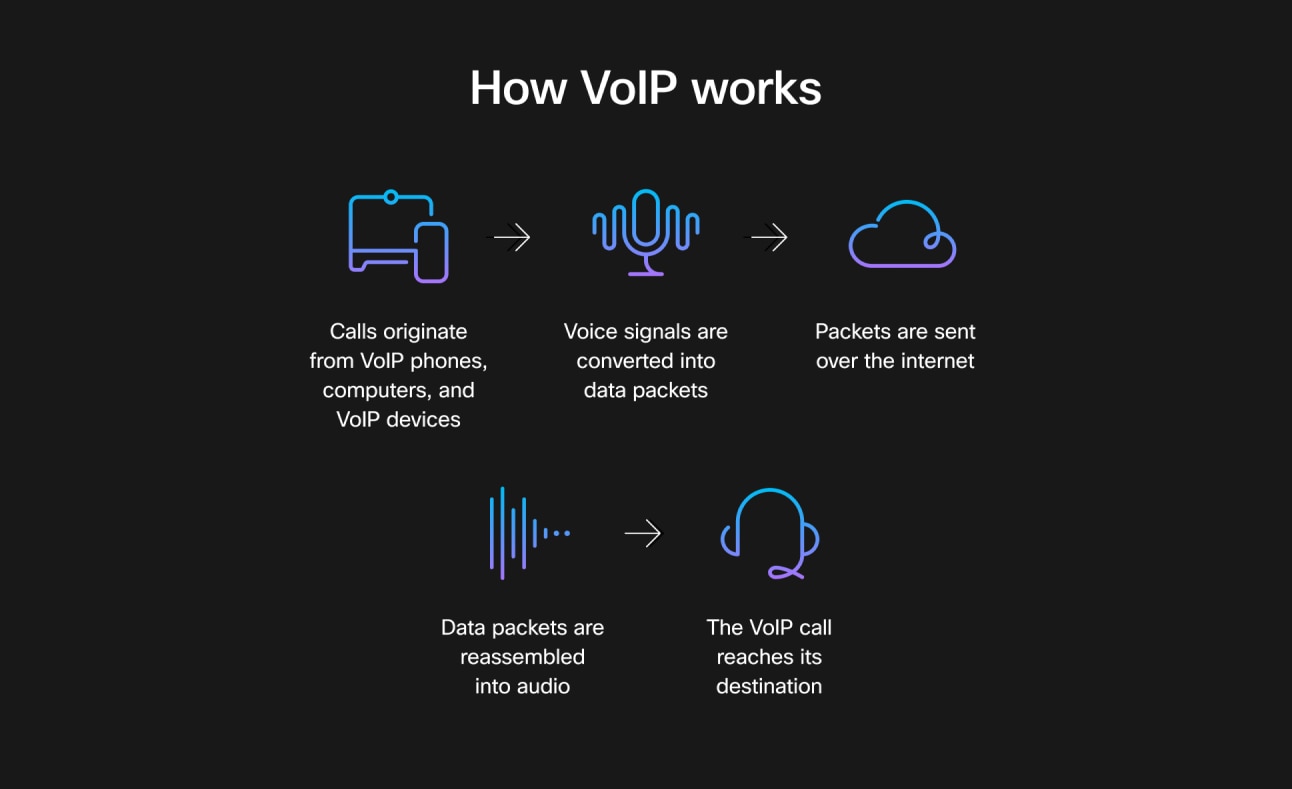
In contrast to traditional PSTN, VoIP doesn't use physical phone lines or cable systems. VoIP enables users to make or receive phone calls via a broadband internet connection, also called IP telephony. In this sense, VoIP is the underlying technology that enables the transmission of voice and other multimedia content over the internet. Before going deeper, let's decipher the VoIP acronym a bit further:
- Voice over: VoIP packages voice signals into smaller data packets over the internet and sends them to the recipient.
- Internet Protocol: Web-connected devices using their unique “IP address” identify themselves to each other on the internet.
Basically, VoIP phone calls synthesize your analog voice signal into a digital format before transferring it over the internet to an awaiting IP address. If you're calling a regular telephone number, that digital signal is converted into a traditional signal before reaching its recipient. Whether you're calling a VoIP device or a regular PSTN phone, VoIP technology ensures all calls are connected within milliseconds.
There are three primary types of VoIP calling:
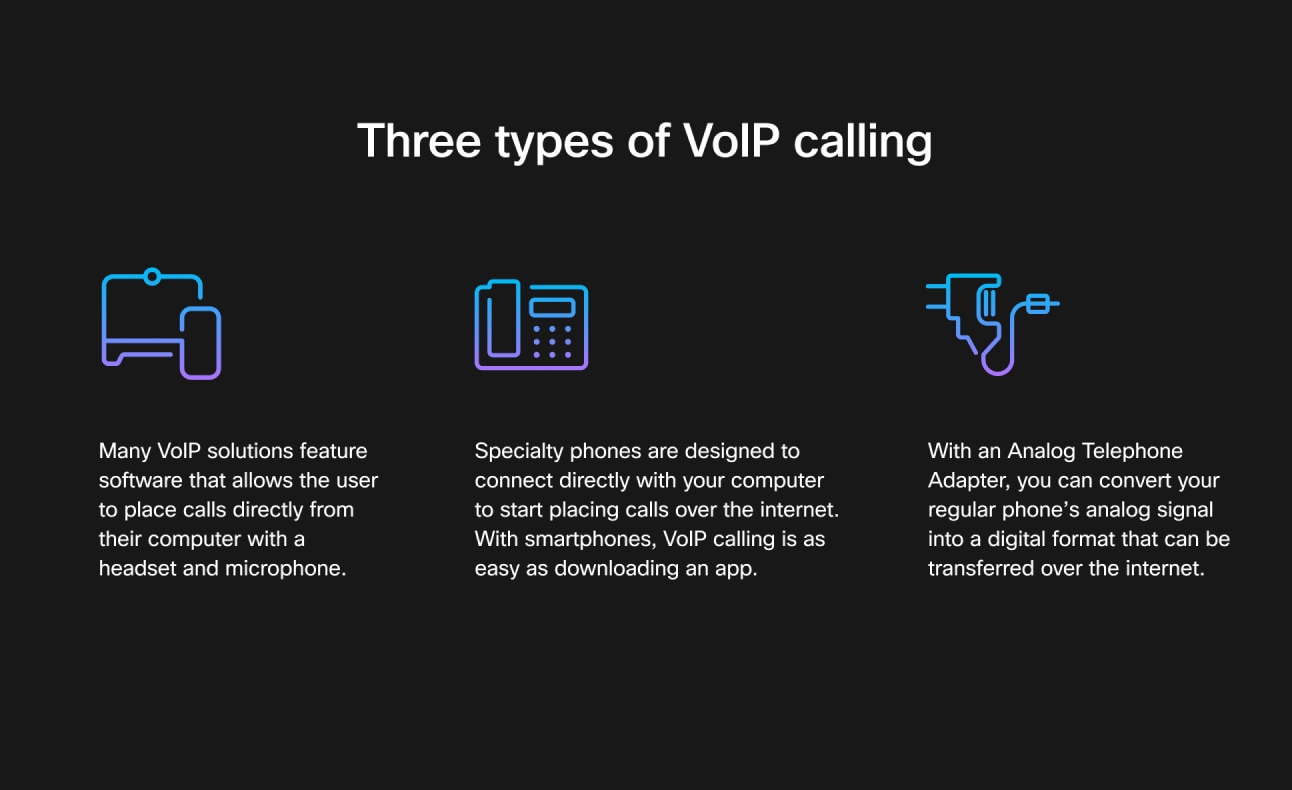
1. Computers and mobile devices
Many VoIP solutions feature software that allows the user to place calls directly from their computer with a headset and microphone.
2. IP telephone
Specialty phones are designed to connect directly with your computer to start placing calls over the internet. With smartphones, VoIP calling is as easy as downloading an app.
3. Analog phone
With an Analog Telephone Adapter, you can convert your regular phone's analog signal into a digital format that can be transferred over the internet.
That's right — VoIP phone systems allow you to place cloud calls on a phone, computer, or mobile device. Only an internet connection is required to start VoIP calling, which means adoption and migration from traditional phone systems can be simple.
What's the difference between VoIP and PSTN?
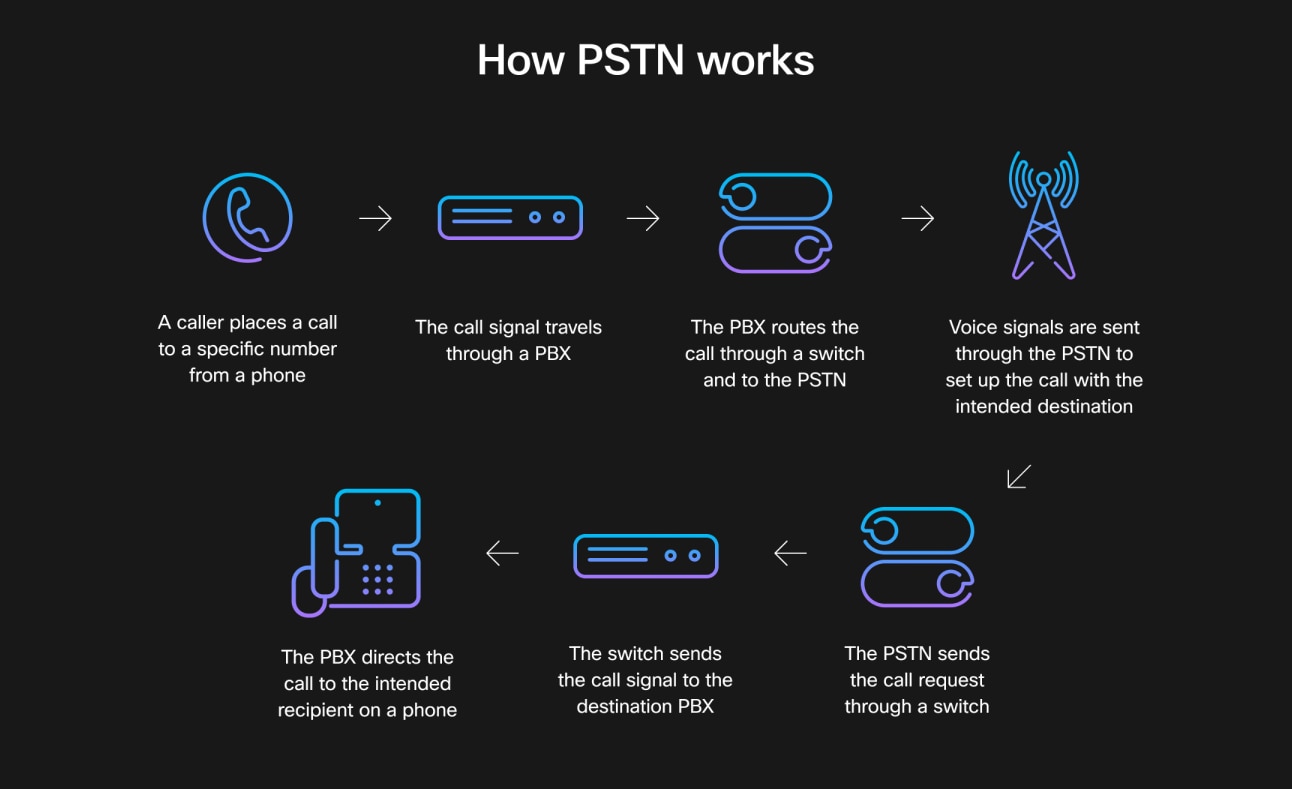
As VoIP calling continues to grow in popularity, it is important to consider how and why it is surpassing past telephony technology.
In contrast to VoIP, traditional analog landlines and cellphones depend on a Public Switched Telephone Network (PSTN). A PSTN is a combination of telephone lines, fiber optics, switches, cellular networks, satellites, and cable systems. All of these elements connect and enable telephones to support phone calls between points. This type of calling–the type most people are used to–uses circuit-switched telephony to carry analog voice data over copper wires and fiber-optic cables.
In place since the late 1800s, PSTN relies on physical infrastructure. If for any reason phone lines go down, critical business calls could be lost. PSTN requires a connection via a physical landline, while VoIP enables connections anytime, anywhere via the internet. What's more, PSTN cannot offer the additional collaboration features such as video meetings and mobile messaging that VoIP calling provides to further enhance the collaboration process between team members.
Whereas VoIP requires only an internet connection, PSTN necessitates dedicated phone lines from your telecom provider. By extension, because you can quickly add more users without adding more infrastructure, cloud-based VoIP calling is inherently more scalable than traditional phone systems. In addition, upgrading the traditional PSTN telecom system requires significant hardware and software acquisition, installation, and maintenance–all at the cost of the business.
That being said, VoIP can also be used to connect to the PSTN and vice versa. For instance, Webex Calling supports customers with the ability to select PSTN connectivity on a site-by-site basis. Webex customers can use any combination of Cisco Calling Plans, Cloud Connected PSTN, or Local Gateway-based PSTN across different sites.
Why use VoIP for business?

Businesses continue to move toward a hybrid model of working. In fact, a recent Webex study conducted by Dimensional Research indicated that 57% of employees expect to be in the office 10 days or less each month. That means businesses must devise communication and collaboration strategies that incorporate on-premises, remote, and hybrid workers. For example, the recent study found that nearly half (46%) of respondents wanted consistent tools at home and in the office, as well as meeting and collaboration technology with the same interface (47%).
For a hybrid organization to stay on the same page, they need a communication solution that offers a frictionless user experience. Better yet, they need a solution that fosters collaboration with tools such as real-time translation for more than 100 languages and breakout rooms to facilitate smaller, focused group discussions. To create this advanced hybrid workplace, businesses of all sizes will turn to fully featured cloud calling.
When communicating through the cloud, there isn't a need for employees to work in close proximity to the in-office phone line. VoIP calling enables workers to access phone lines from anywhere in the world at a moment's notice. Put simply, VoIP streamlines collaboration.
When it comes to choosing the right VoIP solution for your business, the best service provider will make transitioning from one platform to another a seamless experience. In this era of hybrid work, businesses cannot tolerate any disruption. This is an especially important consideration for businesses with a large remote workforce.
What are the benefits of VoIP?

Thanks to their advanced functionality, VoIP phone systems are bridging the gap between remote workers, customers, and business partners. No matter the location of your workforce, everyone in the organization stands to gain from VoIP calling.
Let's explore some of the most substantial benefits of VoIP calling.
1. Reduced capital costs
Private Branch Exchange (PBX) is a system of hardware that many businesses have historically relied on to connect their internal phone network to the public phone network. Not only is this process expensive, it's exceptionally difficult to upgrade and maintain. Cloud-based VoIP, on the other hand, requires only an internet connection.
2. Improved call quality
Employees depend on reliable calling to do their jobs. Poor audio on calls can lead to miscommunications. Webex Calling offers noise cancelling features that use advanced deep learning, speech science, and audio processing technology to separate noise from human speech in any language. Without the background distractions, employees can better focus while collaborating with colleagues.
3. Expanding global coverage
VoIP calling is gaining momentum globally, which businesses and individuals will appreciate as typically VoIP international calling comes at no cost to the caller.
Traditional PSTN phone systems typically charge expensive rates for international calls. For an increasingly global workforce, teams must be able to connect with colleagues around the world—without worrying about expensive long-distance calling.
4. Advanced functionality
VoIP systems not only give the user greater control over their communication from one central location, but VoIP calling also enables businesses to obtain insights and data that help them manage calling, collaboration, messaging, and more—from a single dashboard.
5. Flexible work environments
Mobile phone integration means employees can be easily connected to all their resources, applications, and colleagues while working from anywhere. The result? Mobile workforce responsiveness and greater productivity.
With their business phone in their pocket, employees won't have to worry about synchronizing phone lines, forwarding calls, or finding a laptop to attend meetings. Switching from personal to business numbers is as easy as pushing a button, an essential capability for remote and hybrid workers.
6. Improved collaboration
With a seamless communication system, VoIP boosts productivity. Employees can quickly chat, share their screen, and exchange documents. Colleagues can work together as if they were in the same room, even when they're not. Better yet, user-friendly interfaces based on popular personal applications make for a seamless collaboration experience at work.
7. Easy onboarding
Gone are the headache-inducing days of installing or adding to your PBX system. With a VoIP phone service, companies can port existing business lines or quickly create new ones without outside help. And businesses can add the exact number of users needed—in some cases with a PSTN provider, for instance, companies might have to purchase a block of 12 lines even if they only needed nine.
8. Reduced telephone hardware and wires
Businesses can forgo clunky and complicated hardware thanks to cloud calling. Cloud calling, which uses VoIP, requires only an internet connection and a web-enabled device.
9. Built-in security that protects sensitive data
Cloud security protocols keep critical information under lock and key, which is a vital asset for businesses with increasingly digital workflows.
10. Scalability for evolving workplaces
As a cloud solution, VoIP calling can easily add or subtract phone lines, scaling to fit any growing and changing operation. As more employees adopt a hybrid work approach, their calling capabilities will remain consistent in the office, at home, or at another remote work location.
11. Seamless UX
Whether you're an employee or a customer, the entire calling experience is positive and painless.
With cloud calling, employees with access to the internet can enable their business phone lines to ring on any device, anywhere. Users can easily switch from a call to a video conference, record and transcribe the calls, and hold or transfer calls while also being able to answer a colleague's line.
Most common challenges of using VoIP calling
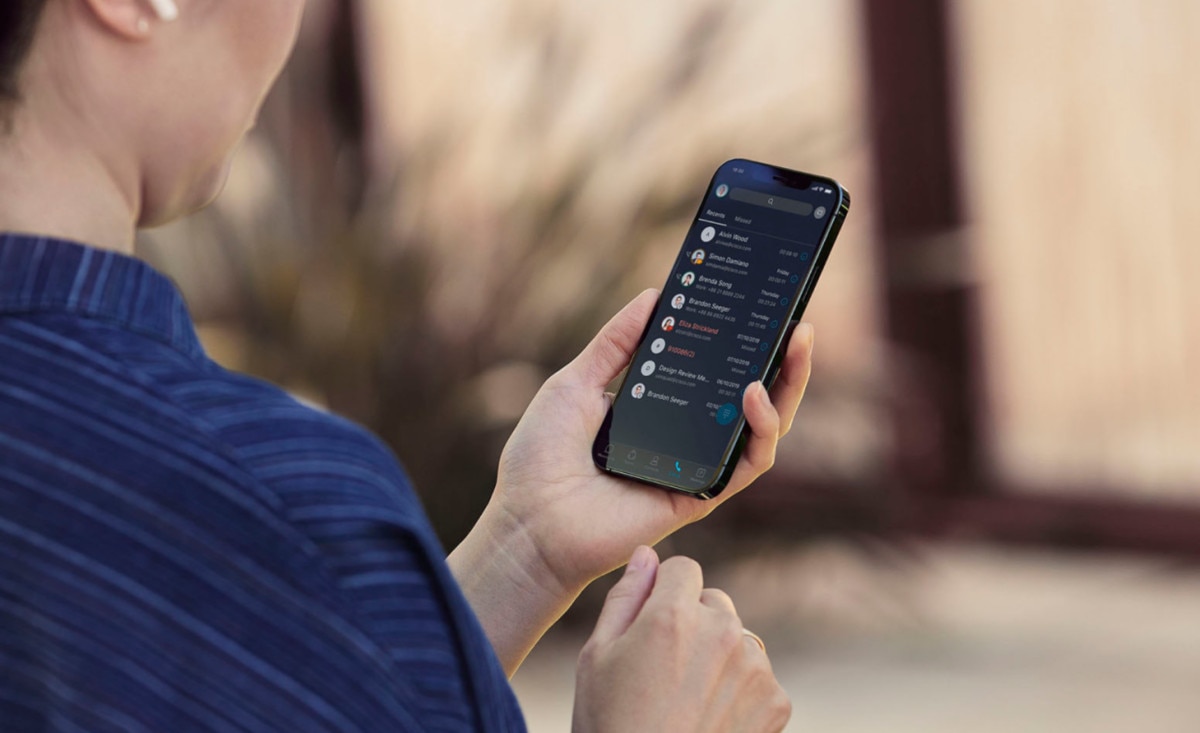
Of course, every technology also brings potential challenges that businesses must navigate. VoIP calling is no exception.
Let's take a look at the possible disadvantages that the best VoIP solutions will aim to mitigate.
1. Poor audio quality
Call quality comes down to minimizing the impact of three significant factors: latency, jitter, and packet loss. Remember, VoIP calling works by compressing audio signals into tiny data packets and sending them over the internet at great speed. To avoid these types of issues, systems can apply Quality of Service (QoS) prioritization across the data network. That means if bandwidth is becoming constrained, QoS policies will give priority to the VoIP traffic to ensure call quality remains high.
Simply put, latency is a voice lag–when the audio signal is delivered but delayed for the receiver. In contrast, VoIP jitters occur when data packets do not arrive in the same order they were sent. During a call, this sounds like shaky and broken audio. Likewise, packet loss occurs when those signals aren't delivered at all, resulting in slow service or a total loss of network connectivity. Packet loss is particularly troubling for video conferencing applications.
The best way to mitigate these risks is to employ a reliable VoIP provider with the capability to handle these issues. Webex up-levels quality under tough network conditions. For example, using region of interest-based encoding, Webex focuses on rendering the most important part of the video—the person's face—with sharper detail. Webex also uses adaptive media resilience tools to cope with extreme packet loss.
2. Dropped calls
Some VoIP callers experience periodic dropped calls—and as a result, loss of productivity among employees. This can interrupt important business meetings and knock employees off their rhythm. Often dropped calls occur when systems are dependent upon hardware, software, and cloud components from varying vendors. For instance, Cisco provides network hardware, IP phones, and a cloud platform, which helps prevent issues such as dropped calls.
3. Slow internet
For businesses using lower-speed internet, VoIP calling doesn't perform at its best. To make the most of a VoIP phone system, the company needs a reliable high-speed connection that can sustain a high volume of phone lines.
4. Outdated infrastructures
Although some analog phones can be converted to IP telephony with an adapter, VoIP typically renders existing PSTN services obsolete. With global plans to decommission PSTN lines in the near future, savvy businesses should be considering VoIP calling today.
For companies that have invested in traditional phone systems, VoIP providers offer incremental migration approaches that enable businesses to maintain business operations while moving to cloud calling user-by-user, group-by-group, and location-by-location.
The right VoIP provider for your business will help you grow your business and enable your employees to work from anywhere with ease. Adopting cloud calling can be carried out in phases, allowing businesses to keep working while upgrading their phone system. And for employees, VoIP calling provides intuitive features alongside advanced capabilities, such as combined calling, meeting, messaging, and team collaboration in one consistent interface across devices.
Cloud calling can mitigate the perceived risks of disrupting business with one comprehensive solution.
How much does VoIP calling cost?
When you take into account the range of functionality and many business benefits, VoIP calling solutions are relatively inexpensive.
In contrast, traditional PSTN services require sizable upfront installation costs–especially on-premises PBX systems. Even worse, regular landlines often include many hidden fees that stack up and result in an expensive bill for the company. These usually include service fees, international calling, and hardware, not to mention the cost of maintaining and repairing systems when they fail.
With VoIP, on the other hand, it's often as easy as downloading an app. Most importantly, the pricing is straightforward (meaning you'll save big on those hidden fees). With Webex Calling, our monthly fee includes everything from services to maintenance and upgrades in our cloud. With a PBX, there can be unexpected costs for hardware and software upgrades, as well as the expense of in-house staff to perform the maintenance.
VoIP service providers also eliminate the need to regularly repair, replace, or maintain your telecommunications infrastructure. With a subscription-based service, the provider handles all of that. Better yet, it's a scalable solution that lets your infrastructure grow with the business.
All in all, when it comes to affordability, VoIP calling blows traditional methods out of the water.
Is VoIP calling easy to implement?
The short answer? Absolutely.
Unlike analog solutions, VoIP is easy to install. Setting up a VoIP phone system is quick and painless, letting you get your business up and running as fast as possible.
If you're connected to the internet, you're already halfway there. Thanks to cloud calling, there's no need to install a complicated physical system. Given our increasingly hybrid work environment, a cloud-based calling platform is much more practical and affordable than an on-premises phone solution.
Even better, jumping from a work number to your personal number can be done at the push of a button. With mobile integration, any employee can easily connect to the company business line and jump into action when needed.
Likewise, adding team members is quick and simple. Companies can manage their entire VoIP calling from a single dashboard. A scalable service, VoIP lets you retract or expand your phone system at your leisure and migrate to the cloud at your own pace.
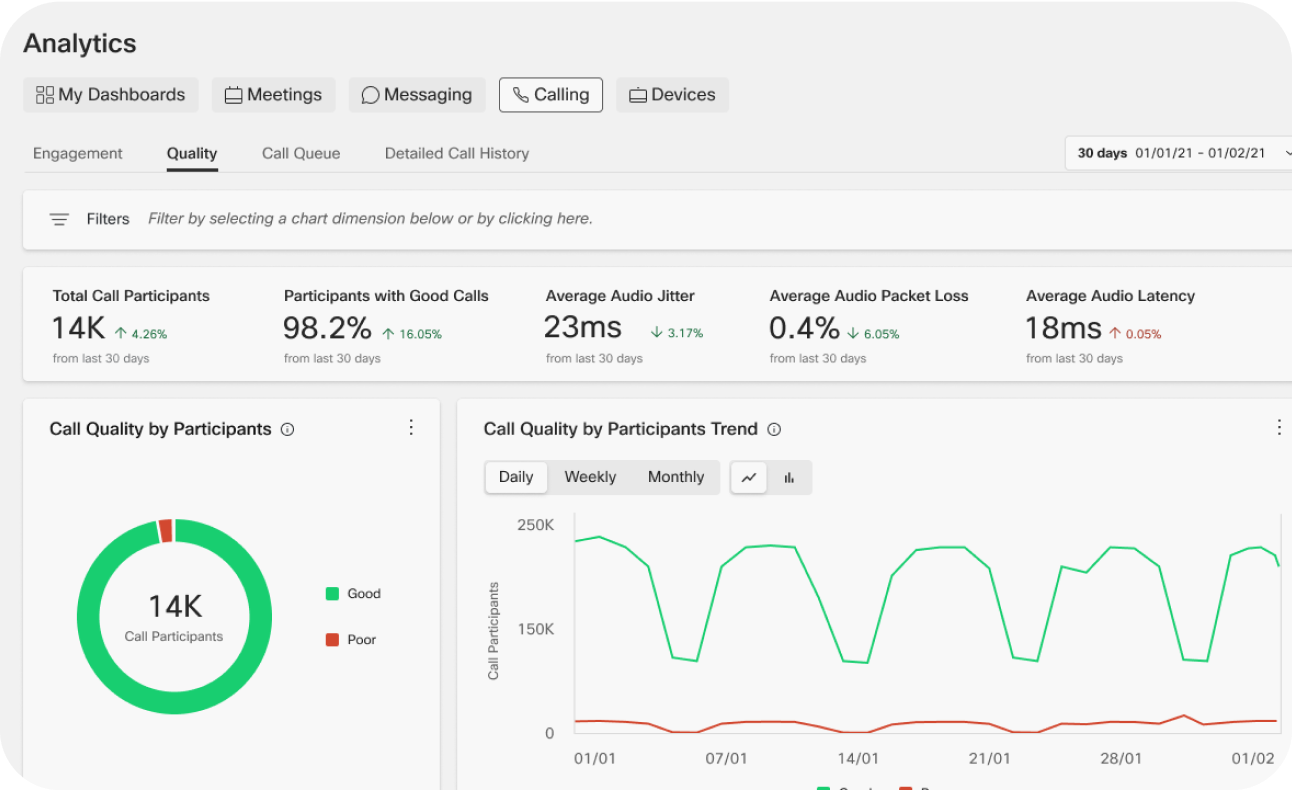
Replacing your PBX network doesn't need to be an overnight leap. Your organization can take those steps on your own schedule with flexible licensing options and VoIP calling plans.
Must-have VoIP features and solutions
VoIP calling promises its users a range of advanced functionality. So what can VoIP actually do?
To answer that question, it all comes down to your specific business needs. Let's explore the top VoIP features both enterprises and small businesses should be looking for:
Enterprise VoIP solutions
1. Next-gen mobile calling
Integrate your workforce's personal mobile phones into your business phone system with ease.
With Webex Go, your workers can make business calls on their personal mobile phone using their native phone dialer. Employees can jump between their personal and work line with ease for a flexible, seamless user experience. And they can easily transition between devices without leaving an ongoing call.
2. Background noise removal
Many hybrid or remote employees are working in noisy, public places. The best VoIP solutions enable the user to eliminate background noise and other distractions to keep everyone focused on the task at hand.
3. Call-to-meeting elevation
Any call can become a group meeting in a matter of seconds. This allows workers to collaborate quickly and efficiently at a moment's notice. With this tool, you can begin with a simple conversation and easily leverage advanced collaboration features as needed throughout—no need to hop off the call to start a new meeting room.
4. Cloud security
High-level cloud-based security protocols protect your infrastructure. Calls are encrypted and sent through multiple channels to prevent unauthorized access to your network. Plus, cloud security automatically updates to the latest protective settings.
VoIP solutions empower businesses with enhanced uptime reliability. With VoIP calling, there's no disruptive downtime throwing critical workflows off track.
5. Fully featured communication
The most advanced VoIP solutions support the full array of communication: instant messaging, group chats, file sharing, screen sharing, and breakout sessions. With so many options, employees can collaborate with ease.
6. Enterprise calling features
VoIP calling offers cloud reliability with all the features of PBX. These features include call merging, waiting, forwarding, and recording; do not disturb, and visual voicemail, among many others.
Best of all, you can control all these features from one central admin portal that offers robust data and analytics.
VoIP for small businesses

When it comes to SMBs, searching for a VoIP solution can often feel like a trade-off. Not all VoIP providers carry all features. Some may have voicemail transcription, for example, while others do not.
This is why small businesses need a fully featured business phone solution. The best VoIP providers will include the entire range of capabilities, including:
- A single business phone number
- Phone menu and call routing
- Call waiting
- Hold/resume
- Call forwarding
- Call transferring
- Visual voicemail
- Built-in security
- Caller ID
How to choose the best VoIP calling provider
The pandemic accelerated the reality of hybrid work across industries; Gartner forecasts that by 2023, the number of remote workers will have doubled to over two-thirds of digital workers, shifting buyer requirements to demand work-anywhere capabilities.
Gartner also reports that this year 5% of organizations will rely solely on cloud office suites for their business communication needs, including telephony—a significant increase from 2% in 2019. But not just any VoIP phone system will provide the optimal experience for your business. You need a reliable solution that fosters collaboration while providing a simple, flexible, and secure user experience. To identify the right choice, ask yourself the following questions:
Is this solution flexible?
VoIP phone providers aren't a one-size-fits-all solution. You need the service with the built-in scalability to meet each and every business need, both now and in the future. Cloud-based calling allows you to migrate away from PSTN at your own pace.
Is it easy to use?
The last thing any business needs is a cloud calling solution that disrupts important workflows or is difficult for users to adopt. With Webex Calling, employees can centralize their communications by utilizing one easy-to-use app for calling, meetings and messaging.
Given the growing hybrid workforce, it's more important than ever to communicate and collaborate with colleagues using consistent tools, interfaces, and technologies. Employees need a full suite of collaboration tools to stay on the same page and perform at their best.
Is this a reliable solution?
No matter the size of your business, it's imperative that your critical calls are never disconnected or disrupted by unplanned downtime, packet loss, or latency.
Webex automatically optimizes video and call quality no matter what type of device you're using. We understand the importance of a seamless, secure, and connected calling experience. Learn more about how Webex's cloud calling solution can transform communication and collaboration for your team.
Dive deeper into VoIP calling technology

12 reasons to replace your SMB's phone system
Is your business still using a traditional PBX phone system? As systems age and older phones become obsolete, you're left bearing the costs of managing calling infrastructure. If you change your location, the expense of rewiring a new office can be prohibitive, and a restrictive on-site PBX fails to satisfy many of the needs of remote workers.

Why transition to the cloud?
Although video conferences have taken center stage as remote work has become more common, audio calls are still integral to collaboration. Hosting and conducting these calls in the cloud, via a cloud calling solution, is the best way for businesses to scale their communications in a multi-device world and to unify the calling and meeting experience.
More commonly asked questions
-
What is a VoIP caller?
Put simply, a VoIP caller is anybody who places a call over the internet. A VoIP caller differs from a typical caller only in that they're not using traditional cell towers, wires, or fiber-optic cables to make their call, and that they likely enjoy VoIP's advanced cloud calling capabilities.
-
What is a VoIP phone?
A VoIP phone is any device that facilitates calling over the internet using Voice over Internet Protocol (VoIP) technology instead of traditional analog telephony.
There are two main types of VoIP phones: hard phones and softphones. Hard phones look like traditional phones, but they're IP-enabled so they can make calls via the internet. A softphone is any device (computer, smartphone, tablet, etc.) that's been equipped with VoIP calling capabilities via a software application.
-
What is a VoIP number?
A VoIP number is the phone number assigned to you when you move to a VoIP phone system. The difference between a VoIP number and a traditional phone number is that a VoIP number is assigned to a user and not a specific phone line. You can choose to keep your existing number or get a completely new number. If you want to keep your current phone number, it'll be ported over to the new VoIP system. Callers can still reach you at the number, but it will ring on whatever device you've enabled to work with your new VoIP phone system, whether that's your mobile phone, your computer, or an IP-enabled desk phone.
Depending on carrier relationships, cloud calling providers can offer local numbers. For instance, if the provider doesn't have a relationship with the local carrier they cannot provide a local phone number with their service.
Webex Calling offers three options for customers to get phone numbers:
- Cisco Calling plans
- Cloud Connected PSTN (Public Switched Telephone Network)
- Local Gateway
With Cloud Connected PSTN and local gateway, customers have the ability and flexibility to select from different carriers.
-
What is a VoIP headset?
VoIP headsets connect to IP phones or other VoIP-enabled devices via Bluetooth or a wired connection, helping enable clear audio during a VoIP call. These headsets often also offer productivity features like in-ear notifications when it's time for a meeting and controls that allow you to answer a call right from the headset.
Depending on your needs, other features to look for include a good microphone, high-quality audio, noise cancellation, background noise removal, wireless connectivity, and enterprise-grade security.
-
Which countries can use VoIP?
Webex calls using VoIP can be made in any location that there is internet connection, and currently Webex Calling service is available in 85 countries.
-
How does 911 work with VoIP?
Since VoIP calls can be made from anywhere you have an internet connection, emergency services may face challenges in determining the location where your emergency call came from. To address these and other potential challenges, the U.S. government has passed laws to safeguard anyone dialing 911 from a multi-line telephone system.
Kari's Law requires that when 911 is dialed from a multi-line telephone systems (MLTS), the call be routed to the proper Public Safety Access Point (PSAP), without requiring the caller to dial a prefix, such as “9”. It also required a notification to be sent where someone is likely to see or hear (e.g. security office). In addition, phase 1 of RAY BAUM'S Act required that the MLTS must notify a dispatchable location for on-premises and fixed devices to the local PSAP. In early 2022, phase 2 of RAY BAUM's Act took effect, and it requires that a dispatchable location for non-fixed and off-premises devices be conveyed with all 911 calls to the appropriate PSAP.
VoIP providers like Webex have rolled out features to keep callers safe and comply with these laws. For example, with Webex's Nomadic E911 services, when someone makes an emergency call, Webex will provide accurate location information to emergency services for a fast, location-specific response. When setting up your VoIP system, pay special attention to your emergency calling needs and make sure you have all related features properly configured and tested.
-
Are VoIP calls free?
VoIP calls can be a very affordable option for businesses. Once you purchase a VoIP plan, there is no additional charge for VoIP calls, aside from your normal monthly internet bill. There is no need to worry about expenses like high international calling fees.




